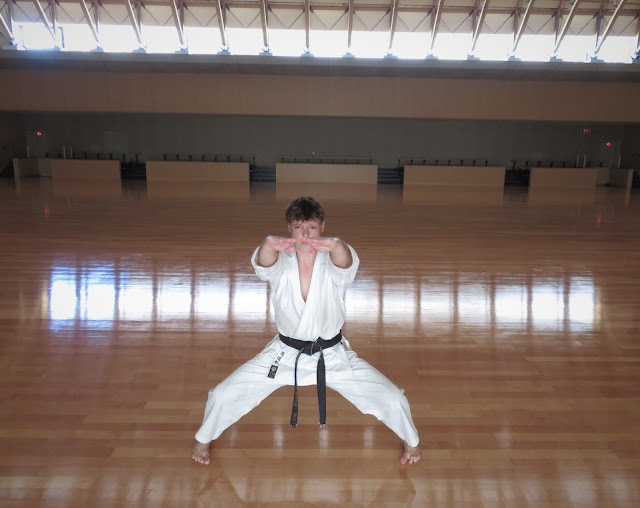The 足の小指 or
small toes are very important in karate, in regards to the direction of one’s
feet. Of course, I could list all the 立ち方
(tachikata)/stances of karate; however, by merely using the three main
‘extended stances’ in kihon practice—騎馬立ち(kiba-dachi),
前屈立ち(zenkutsu-dachi) and 後屈立ち (kokutsu-dachi)—this
aspect will be more than clear. I’ll also clarify some other related points in
this article, but I’ll address those later.
Allow me to explain why the 小指 (small toes) are so important in karate…
Firstly and obviously, they are weakest
toes of the feet.
Secondly, as said above, the direction they are pointing is
what really establishes the direction of your feet (as a general rule, please note this, on my kokutsu-dachi point, which I'll state at the end of this article). Firstly think of
kiba-dachi. If your ‘pinkies’ are perfectly pointing straight ahead, there is
actually a slight inversion of both feet. This is the same with the pillar
(rear) leg of kokutsu-dachi. That is, the small toe is ideally 90 degrees so
that, like in kiba-dachi, there will be a slight inversion of the foot towards
the front. As stated before, I will leave the lead leg of kokutsu-dachi for now, and that will become obvious why later.
Looking at zenkutsu-dachi the front foot is, of course slightly inverted. Again, this position is dictated by the koyubi. That is, by just pointing the foot generically forward is insufficient. Rather, it is the small toe pointing forward; thus, resulting in the inversion of the entire foot. Indeed, we must also look at the rear foot in zenkutsu-dachi as well. Again, ideally speaking, the rear foot is less than, and no greater than, 45 degrees to the front; moreover and once again, the focus here should again be on the koyubi.
Thirdly, why is all this the case? Well, as stated this part of the foot is the weakest, therefore, we must use it in harmony with the stronger toes: the strongest, of course, being the big toe.
Furthermore, there
is another very important point: 足刀
(sokuto). In Shotokan, a critical basic in kihongeiko is “keeping the entire foot as flat on
the floor as possible”. The main focus, in this regard, is keeping ‘sokoto
down’ as opposed to the common error of ‘rolling them over’, which results in
instability of the respective leg in question.
This rule is only in classical training, nevertheless, when
strictly adhered to, when engaging in freestyle, it makes one’s natural movement
much easier. In this regard, optimal is the best word. Put another way,
standing in a natural jiyu dachi, it is like ‘taking the breaks off’ (when
moving with agility and reactively is the priority). In addition to this, it allows one “…to
retain and recover balance when executing
full speed and full power techniques against an opponent”, or any other
physical target (sandbag, focus mitts,
etc. Notice something here??
What I’m elucidating here is “…that when ‘throwing techniques into the air’ (I.e. – solo kihon and kata) we keep the feet flat”; that is, sokuto down. Now, please always keep in mind that this intrinsically relates to the 小指 (koyubi). The only exception to this is the classical Yakusoku-Kumite: 五本組手 (Gohon Kumite), 基本一本組手 (Kihon Ippon Kumite), and the most basic form of 自由一本組手 (Jiyu Ippon Kumite). To put this in context, these methods of Kumite must be recognized for what they really are: ‘Partner Kihon Drills’ which “…train the classical techniques of karate—with another person/opponent—and progressively bridge the gap closer towards Jiyu Kumite: whilst mitigating the loss of kime in techniques”.
So, we can see that sokuto is not only for kicking…
Moreover, the importance of the 小指
(small toes) for precise foot directions, which not only result in beautiful
foot positions in stances but optimize the feet for explosive speed and power;
balance and recovery; and generically speaking, fine tuned bodily control.
OK, so if you closely read above, you will notice that I
purposefully left out the lead leg of kokutsu-dachi. Well, I did that on purpose
as it is what I personally term as ‘a rule breaker’, which is a constant in karate and all
forms of budo for that matter. In this case, the entire foot points forward as
opposed to the small toe. This is because the prime focus is on the compression
of the rear leg and the front foot establishes one’s line for power transition
as opposed to being directly for function itself. This also enables a neutral
position for a kizami-geri; however, this somewhat deviates from the focal
points of this article.
To conclude, by properly understanding, and applying of your
koyubi, you can readily achieve professional classical stances with Japanese flavor;
furthermore, these classical positions and the resulting unsoku/footwork from them, will greatly enhance
one’s Jiyu Kumite and ability to defend oneself.
© André Bertel. Oita City, Japan (2022).




No comments:
Post a Comment
Note: only a member of this blog may post a comment.